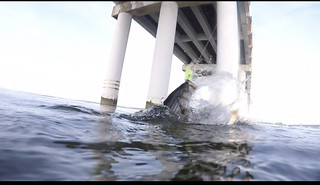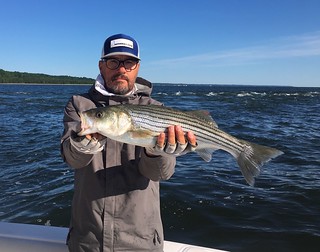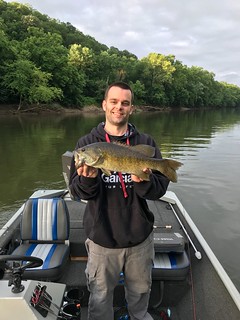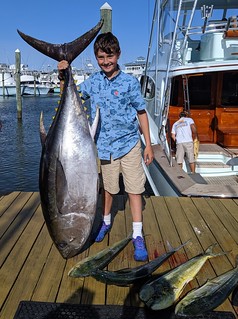Maryland Fishing Report – June 12
This is a special weekend for sons and daughters to celebrate their love for the fathers – or father figures in their lives — who help them to appreciate the gifts of the outdoors. No doubt many will take out the gear this weekend and share that special time together that fishing provides. Happy Father’s Day!
Chesapeake Bay waters will be slowly warming, with mostly cloudy conditions and expected air temperatures in the low to mid 80s during the daytime and in the high 60s at night. Rains are likely Wednesday and again early next week. Salinities are still running very low for this time of year, only about 10ppt near the Virginia state line. In most of the shallower bay waters, anglers will find adequate oxygen for gamefish from surface to bottom. However, to avoid low oxygen conditions in the deep channel waters from the Bay Bridge down to the state line and the lower Potomac River, avoid fishing deeper than 35 feet. However, on the east side of the Bay Bridge, Buoy R78 (near mouth of Little Choptank) and down along the eastern side of the Chesapeake and the mid-bay islands, avoid fishing below 20 feet. To see oxygen levels by depth, check our online “do not fish below this depth” map.
Water temperatures have mostly remained stable this week for the upper bay, but have slowly increased in the lower bay. For the middle-to-upper bay — from Annapolis north — water temperatures are holding in the mid 70s. For the middle-to-lower bay, surface waters are holding in the low 70s. Choptank area water temperatures also are rising to the upper 70s and low 80s. For the Potomac River, at Little Falls and Point Lookout, surface water temperatures are holding in the mid to the upper 70s. To see water temperature by depth, check our “water temperature by depth” map.
Expect decent water clarity on Maryland’s portion of the bay mainstem below Tolchester and at Colonial Beach on the Potomac River. However, algal blooms are beginning to appear in Fishing Bay and in the Bush, Gunpowder, Nanticoke, upper Patuxent and Wicomico rivers. Expect normal flows from Maryland’s rivers and streams this week. There will be above average tidal currents from Thursday through Tuesday as a result of the upcoming full moon June 17.
For the full weekly fishing conditions summary and more detailed and up-to-date fishing conditions in your area of the bay, be sure to check out Click Before You Cast. You can now get regular updates on Maryland’s waters and the creatures that call them home sent to your inbox with our new Eyes on the Bay newsletter. Sign up online.
The Conowingo Dam is in a power generation phase, with water releases usually occurring during the midday hours. Although we have not had a major rain event lately, salinity values will continue to remain below normal in the upper bay for quite some time. In the lower Susquehanna River and Elk River complex, fishing for striped bass has been relatively slow. The best bite has been for those casting swimbaits and topwater lures in the early morning and evening hours along the edges of the Susquehanna Flats. Most of the striped bass being caught are below 19 inches, but a few can be caught above that mark.
A little farther down the bay there has been some chumming action at Swan, Love and Podickory points along the channel edges there. Anglers fishing there suggest bringing plenty of bait since the ratio of catfish to striped bass has been high.

Travis Long was jigging at the Bay Bridge and sent us this cool picture of a big striped bass fighting to the surface. Photo by Travis Long
The eastern side of the Bay Bridge from the sewer pipe to the bridge piers seems to be the best concentration of striped bass in the region. Dissolved oxygen levels have reached unacceptable levels in the deeper waters of the bay due mostly to insufficient mixing with surface waters and dissolved oxygen depletion from decomposing organisms.
What this means to fish — particularly striped bass — is they have to stay close to the surface where there is plenty of oxygen mixing from the action of wind and waves. Strong westerly winds will help with oxygen mixing on the eastern side of the bay. The current that runs through the bridge piers on the eastern side of the bay also helps with this mixing. Put all of this together and the striped bass are holding in water less than 15 feet deep. Charter boats could be seen this past weekend almost gunwale to gunwale near the bridge chumming for striped bass.
Non offset circle hooks are now a must when chumming OR when using live fish or live eels as bait (live-lining), as seen demonstrated in a short video online.
Jigging around the bridge piers has also been good and offers the ability to target larger striped bass with soft plastic jigs in the 6-inch to 8-inch range. Some anglers have had luck drifting soft crab baits back to the piers, while others are using live eels with similarly good results. Rifting these baits or even live white perch has also been good at the Francis Scott Key Bridge piers.
Fishing for white perch has been good and most agree quality and size of the perch is wonderful. Fishing pieces of bloodworm or grass shrimp on bottom rigs has been popular in deeper waters, along with dropper fly rigs. Fishing relatively shallower water has been offering plenty of fun for those casting beetle spins, small spinners or jigs around shoreline structure.
Trolling has been one of the more popular ways to fish for striped bass. Most anglers are having the best success in waters less than 30 feet deep along channel edges and rock piles. The inside edge of Bloody Point – known as the Wild Grounds – along with Hollicutts Noose and the Gum Thickets to the north have been popular places to troll this week. Red hoses have been a productive item to troll as well as swimshads and bucktails behind umbrella rigs. Spoons behind inline weights have also been a part of many trolling spreads.
Jigging with large soft plastics and light weight jig heads along these same channel edges has been a good option when suspended fish can be spotted on depth finders. The shallow water striped bass fishery continues to be disappointing in areas like the lower Choptank River, the fish just don’t seem to be there. There is some limited action by casting topwater lures and swimshads at the rocks at Poplar Island and Thomas Point during the early morning and late evening hours.
White perch have been providing plenty of fun fishing action for all ages. This type of fishing can be as simple as dropping a small sinker and hook baited with pieces of bloodworm or grass shrimp straight down off a dock. White perch love structure and often can be found hugging dock piers or bulkheads. In areas such as Eastern Bay, bottom rigs with bait or dropper flies can work well for white perch holding on oyster bottom. Casting beetle spins and small lures is another way to fish along shoreline structure.
Channel catfish can be found in areas where they are not often seen this time of the year. Low salinity values have them moving freely throughout the bay and lower sections of the tidal rivers. Blue catfish are also becoming part of the mix now and most likely will become more common in the near future. Those chumming for striped bass in the bay are catching a lot of catfish, and they can also be targeted in the tidal rivers. Bill Burton Fishing Pier State Park on the lower Choptank has been a very productive place to catch them for shorebound anglers.
A fun northern snakehead fishing derby held last Saturday at Harriet Tubman Underground Railroad State Park in lower Dorchester County was a big success for all who attended. There were 107 registered fishermen of all ages having fun learning about northern snakeheads and competing for prizes.
Chumming, trolling and jigging have all been popular, viable ways to fish for striped bass. The lower Potomac River has been one of the more popular places to fish for them. The steep channel edge that runs from Piney Point to St. Georges Island continues to hold a concentration of fish.

Eric Packard jigged up this nice striped bass at the Calvert Cliff Power Plant discharge. Photo courtesy of Eric Packard
Chumming at this channel edge offers good opportunities for a mix of striped bass and blue catfish — the 30-foot edge tends to be the sweet spot. Anglers are encouraged to not get too upset about the blue catfish mooching baits — bring plenty of bait and pack those blue cats in the cooler, as they make wonderful eating. There has also been chumming opportunities in the lower Patuxent River below the Hawks Nest and over on the eastern side of the bay shipping channel near Buoy 72B.
Trolling has been a good way to connect with striped bass that can be found along channel edges. The east side of the bay shipping channel from Buoys 76 down to 72B, the Cove Point channel edge, and the lower Potomac and Patuxent rivers all are good places to troll. The Patuxent River up to Sheridan Point has been offering good trolling. Most are using a mixed spread of lures, including bucktails and swimshads in tandem or behind umbrella rigs, spoons and red hoses behind inline weights or planers.
Jigging is a great way to fish for striped bass at the same channel edges where chumming and trolling is taking place. Exploring various channel edges with depth finders can pay off when suspended fish can be located. Large soft plastics with light jig heads have been the favorite way to jig. Some are having good luck with skirted jigs and large eyes on their jig heads.
There continues to be some shallow water action on the eastern side of the bay along the marsh edges and cuts. Casting spoons and similar topwater lures along marsh edges and stump fields has been producing a mix of striped bass and speckled trout. Casting swimbaits such as white Gulp mullets has also been a good tactic along with drifting soft crab baits in the various guts and channels for speckled trout and red drum.
White perch can also be found along the marsh edges and also on the western shore creeks. Bottom fishing in some of the deeper areas with pieces of bloodworm or grass shrimp has been good for white perch. Substantial numbers of croaker and spot have failed to show up on the western shore or the Tangier Sound areas. Low salinity values in the lower bay region may be to blame.

Rick Norris holds up a beautiful upper Potomac smallmouth bass for a quick photo. Photo courtesy of Rick Norris
In Western Maryland, fishing at Deep Creek Lake is beginning to take on a typical summer mode of opportunities. Largemouth and smallmouth bass can be found under or near floating docks. Largemouth bass can be also found back in the shallower coves under grass or fallen treetops, smallmouth bass near deep grass. One of the best places to look for trout is along the dam face, and slow-trolling nightcrawlers on worm rigs is a good way to target them. The early morning hours offer some of the best fishing and also less boat traffic.
The Maryland Department of Natural Resources is expanding its popular loaner tackle program to Rocky Gap State Park, offering park patrons free use of fishing gear and tackle. Eight youth-sized fishing rods have been refurbished and several tackle boxes have been donated to help promote youth fishing at the park. The loaner fishing rods and gear are available at the park’s camp store.
The upper Potomac River is running strong but may calm down later on this week if we do not receive a lot of rain Wednesday night. Smallmouth bass have been the main target for those out on the river. Casting topwater lures, stick worms, flukes and lipless crankbaits in the shallows near grass during the early morning hours is great fun. Working jigs and deep running crankbaits work well out in the deeper waters of the river.
Trout fishing is also settling into a summer mode. Fly fishing comes into its own as anglers try to match hatches of midges, sulphurs, caddis and others with dry flies. Streamers also work well, and spin casters can use a variety of flashy spoons and spinners.
The tidal Potomac and the other tidal rivers of the bay are offering good largemouth bass fishing in the early morning or late evening hours near grass. Frogs, buzzbaits and stick worms are all good baits to use while working shallow grass. Northern snakeheads will also be part of the mix in these grassy areas. As the day wears on, targeting largemouth bass loafing under thick grass or shade from brush, fallen treetops or old docks is a good tactic. Dropping stick worms or soft plastics through the thick grass or pitching under docks and overhanging brush is a good way to entice a bass to pick up a bait. If you are in a tidal river, don’t forget to target the outside edges of grass beds and spatterdock fields on an ebb tide with spinnerbaits, jerkbaits or crankbaits.
Crappie are holding close to structure this week and can be caught on minnows or small jigs under a bobber. A mix of yellow perch and white perch can be caught along the edges of tidal rivers by casting beetle spins. Just about every tidal river of the Chesapeake has good populations of channel catfish, and blue catfish are increasing in number and distribution.

Mason Koehler poses with a nice bigeye tuna caught at the Baltimore Canyon. Photo courtesy of Dustin Koehler
The surf fishing scene has now shifted to a typical summer mode. Kingfish as well as bluefish are common targets. The kingfish are being caught on pieces of bloodworms or Fishbites on a bottom rig. The bluefish are being caught on cut baits of menhaden or mullet or finger mullet. Casting metal or plugs is also a fun way to catch bluefish. Those casting large cut baits are also catching cownose rays and the occasional inshore shark and cobia.
At the inlet, Route 50 Bridge area, bluefish continue to move in and out of the inlet, providing good fishing for those casting Got-Cha lures, swimshads or drifting cut bait. There has also been a lot of short striped bass lately in the inlet area, and a few large sea trout are being caught.
The back bay waters have cleared up after last weekend’s strong winds clouded up the waters. Clear water makes for good flounder fishing this week. The channels leading towards the inlet such as the East channel and the Thorofare are great places to drift for flounder. Near the airport in Sinepuxent Bay has also been a good place to catch flounder this week.
Outside the inlet, those trolling near the shoal areas and farther out have been catching bluefish, Atlantic bonito, false albacore and some Spanish mackerel. Sea bass fishing has been good at the wreck and reef sites and flounder are becoming a more common addition to the daily catch.
All eyes will be looking to the offshore canyons this week as calmer sea are predicted. Those trolling have been catching a mix of Bluefin, bigeye and yellowfin tuna between Poorman’s and Baltimore canyons.
Offshore anglers are reminded to turn in catch cards for bluefin tuna, billfish and sharks.
“No stocked fish roam the seas. These are fish straight from God’s hand and they are in prime condition.” — Lefty Kreh
Maryland Fishing Report is written and compiled by Keith Lockwood, Maryland Department of Natural Resources fisheries biologist.
Click Before You Cast is written by Tidewater Ecosystem Assessment Director Tom Parham.
This report is now available on your Amazon Echo device — just ask Alexa to “open Maryland Fishing Report.”


